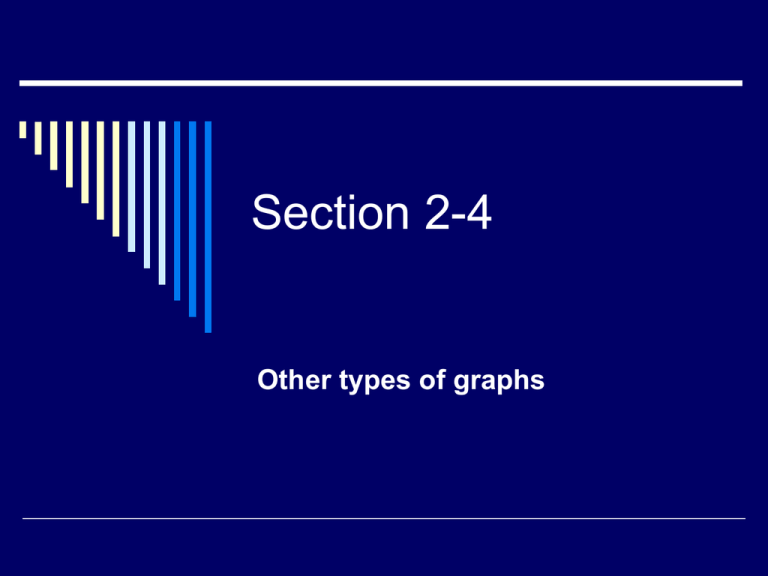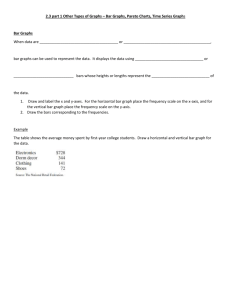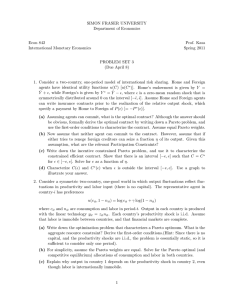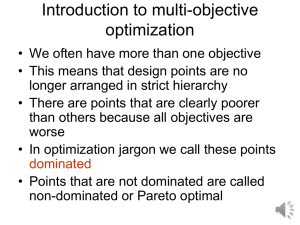Other Types of Graphs
advertisement

Section 2-4 Other types of graphs Pareto chart time series graph pie graph Pareto Chart Used to represent a frequency distribution for a categorical variable, and the frequencies displayed by the heights of vertical bars, which are arranged in order from highest to lowest. Pareto Chart The table shows the number of crimes investigated by law enforcement officers in national parks during 1995. Construct a Pareto chart for the data. Arrange the data from the largest to the smallest according to frequency. Arrange the data from the largest to the smallest according to frequency. Draw and label x and y axes. Draw the bars according to the frequencies. Pareto Chart Suggestions for drawing Pareto charts Make the bars the same width Arrange the data from largest to smallest according to frequency Make the units used for the frequency equal in size Time series graph Represents data that occur over a specific period of time these types of graphs are over 1000 years old. the first ones were used to chart the movements of the planets and the sun. Time series graph In 1958 there were more than 4000 outdoor drive-in theaters. The number of theaters has changed over the years. Draw a time series graph for the data and summarize the findings. Time series graph Draw and label the x and y axes Label the x axis for years and the y axis for number of theaters Plot each point Connect the adjacent points What can you determine? When was the biggest drop? What do you think might have happened in that time period to affect drive-ins? When you analyze a time series graph, look for trends. Is the line ascending? Is the line descending? What is the slope? Is the rate of change rapid, or slow. Does it speed up, then slow down? Does it start slow, then speed up? Compound time series graph When two lines are used. Used for comparison of data. This graph shows the number of snow shovels sold at a hardware store over two seasons Pie Chart A circle that is divided into sections or wedges according to the percentage of frequencies in each category of the distribution. Okay, here comes the math… Since there are 360 degrees in a circle, the frequency for each class must be converted into a proportional part of the circle. This conversion is done using a standard formula. f Degrees 360 n Where f = class frequency and n = total frequency. Each frequency must also be converted to a percentage. Next, using a protractor and compass, draw and label the graph. Next, using a protractor and compass, draw and label the graph. Misleading Graphs Graph of an automaker’s claim A car manufacturer’s ad stated that 98% of the vehicles it had sold in the last 10 years were still on the road. The ad showed a graph similar to this one… Graph of an automaker’s claim Lets consider another example. The percentage of the world’s total motor vehicles produced by manufacturers in the US has declined from 24% in 1998 to 21.5% in 2000, as shown by these data: When you look at the graph… When you change the scale… When you change the scale… Another misleading technique is to exaggerate a one-dimensional increase by showing it in two dimensions. The cost of a Super Bowl ad The cost of a Super Bowl ad The cost of a Super Bowl ad Summary Histogram Used when the data are contained in a grouped frequency distribution. Frequency polygon Used when the data are contained in a grouped frequency distribution. When not as much “visual pop” is required. Ogive Used when the data are contained in a grouped frequency distribution. When cumulative frequencies are desired. Pareto Chart Like a histogram Used for nominal or qualitative variables. Time series graph Used to show a pattern or trend that occurs over a period of time. Pie graph Used to show the relationship between the parts and the whole. Most often uses percentages. Assignment read examples 2-12 through 2-14 do exercise set 2-4 1 – 14











